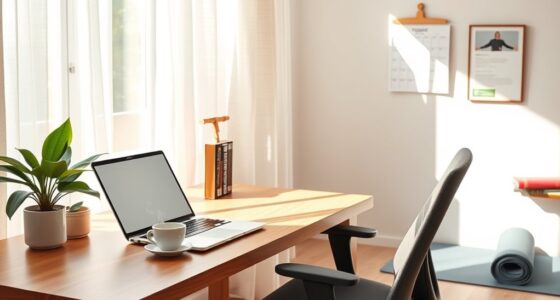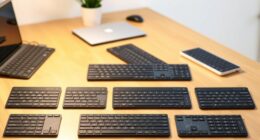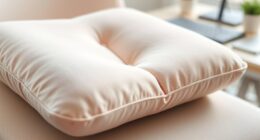To boost your productivity, incorporate quick micro-break exercises like stretching, eye care, and deep breathing into your routine. Stand up and stretch your arms and back to refresh your body, and look away from your screen every 20 minutes to reduce eye strain. Practice slow breaths to stay calm and focused. These simple activities can improve your focus and energy levels. Keep going, and you’ll discover even more ways to enhance your workday effectively.
Key Takeaways
- Incorporate quick stretching routines to improve circulation and reduce muscle tension during work breaks.
- Practice eye exercises like blinking and looking away from screens to minimize eye strain and maintain focus.
- Use deep breathing techniques to reduce stress, enhance mental clarity, and promote relaxation throughout the day.
- Take short physical activity breaks such as standing or arm stretches to boost energy and prevent stiffness.
- Enhance routines with professional eye care tools to improve visual comfort and support long-term eye health.
Simple Stretching Routines to Rejuvenate Your Body

Taking short breaks to stretch can do wonders for your energy levels and focus during the workday. When you incorporate simple stretching routines, you refresh your body and prevent stiffness caused by long periods at an ergonomic desk setup. Stand up, reach overhead, and gently stretch your arms and back to boost circulation. These movements help reduce muscle tension and keep you alert. Pair your stretches with healthy snack options to fuel your body effectively. Staying active during work hours improves overall productivity and mental clarity. Remember, even a few minutes of stretching can make a significant difference, so don’t overlook these quick exercises. They’re easy to do, require no special equipment, and fit seamlessly into your daily routine. Incorporating simple physical activities into your day supports both physical health and mental well-being.
Eye Exercises to Reduce Strain and Improve Focus

Since many of us spend hours staring at screens, eye exercises are an effective way to reduce strain and boost focus. One simple technique is glare reduction: adjust your screen’s brightness and contrast, and use an anti-glare filter if possible. Practice blink awareness by consciously blinking more often; this prevents dry eyes and maintains moisture. Every 20 minutes, look away from your screen and focus on a distant object for 20 seconds to relax your eye muscles. Additionally, rolling your eyes gently in circles helps release tension. These quick exercises reduce eye fatigue and improve your ability to concentrate. Incorporating glare reduction and blink awareness into your routine can make a noticeable difference in your comfort and productivity during long work hours. Utilizing professional equipment can further enhance the quality of your eye care routine.
Breathing Techniques to Boost Mental Clarity and Calmness

When stress or mental clutter build up during your workday, practicing simple breathing techniques can quickly restore your focus and calmness. Try mindfulness meditation by taking slow, deep breaths, paying close attention to each inhale and exhale. This helps you stay present and reduces anxiety. Visualization techniques can also enhance this process; imagine a peaceful place or a calming color as you breathe deeply, anchoring your mind and easing tension. These methods activate your relaxation response, clear mental fog, and improve clarity. Incorporate these micro-break exercises regularly to maintain mental sharpness and emotional balance throughout your day. With consistent practice, you’ll find it easier to manage stress and stay centered, even during busy or challenging moments.
Frequently Asked Questions
How Often Should I Perform Micro-Break Exercises During Work Hours?
You should perform micro-break exercises based on the frequency guidelines for maintaining focus and reducing fatigue. The ideal timing is every 25 to 30 minutes of work, taking a quick 2 to 5-minute break. This helps you stay energized and productive throughout the day. Listen to your body—if you feel tired or stiff, it’s a good sign to pause and stretch, ensuring you follow the recommended frequency guidelines for best results.
Can Micro-Break Exercises Be Customized for Different Types of Jobs?
Think of micro-break exercises as a tailored suit, fitting your unique workday like ergonomic adaptations. You can customize these routines to match your job’s rhythm, whether it’s standing, sitting, or moving. For desk workers, simple stretches work best, while physical laborers might need quick mobility drills. Adapting your micro-breaks to your specific tasks guarantees they’re effective, keeping your body energized and your mind sharp throughout each job-specific routine.
Are There Any Risks Associated With Doing Micro-Break Exercises Incorrectly?
You might worry about risks when doing micro‑break exercises incorrectly, but with proper ergonomic adjustments and stretching safety, you minimize harm. Confirm you don’t overstretch or push into pain, and keep movements gentle. Pay attention to your body’s signals, and adjust exercises as needed. Following safe techniques helps prevent strain or injury, making micro‑breaks a safe, effective way to boost your productivity and well-being during work.
How Long Should Each Micro-Break Last for Maximum Benefit?
Think of micro-breaks like refueling your engine—short and sweet. To maximize fatigue reduction and avoid losing momentum, aim for an ideal duration of about 1 to 2 minutes. This quick pause keeps your energy high without breaking your flow. Stick to these brief intervals, and you’ll find your focus sharp and your productivity soaring. Remember, less is often more when it comes to effective micro-breaks.
Do Micro-Break Exercises Help Reduce Long-Term Health Issues Related to Sitting?
Micro-break exercises can markedly reduce long-term health issues related to sitting by providing ergonomic benefits and mental refreshment. When you take short breaks to stretch or move, you improve posture, reduce muscle strain, and boost circulation. These actions help prevent conditions like back pain and repetitive strain injuries, while also giving your mind a quick reset. Incorporating regular micro-breaks supports your overall health and keeps you more comfortable and focused throughout the day.
Conclusion
So, next time your inbox feels like a never-ending horror show, just remember: a quick stretch or eye roll might save your sanity. Who knew that tiny micro-breaks could turn you into a productivity superstar? Forget caffeine—these simple exercises are your secret weapon against burnout. So go ahead, take a minute, and prove that even a busy bee can pause for greatness. Your overworked muscles—and your boss—will thank you.









